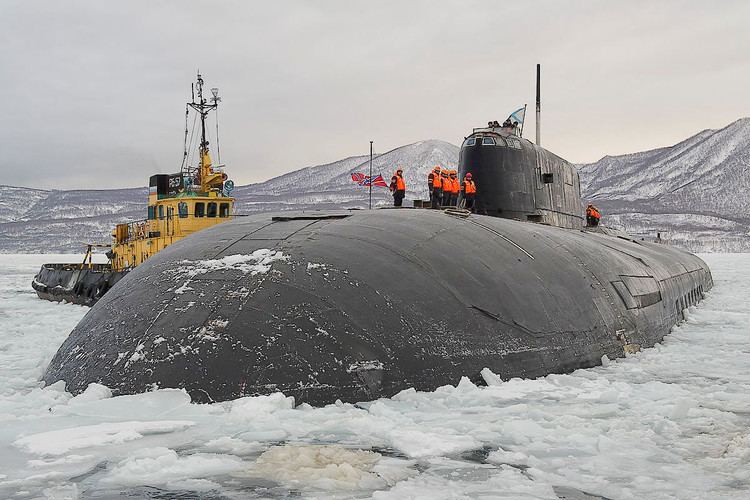Name Oscar ll class Preceded by Papa class Built 1975-1996 | Builders SEVMASH, Severodvinsk Succeeded by Severodvinsk class | |
 | ||
Operators Soviet Navy
Russian Navy | ||
Project 949 (Granit) and Project 949A (Antey) are Soviet Navy/Russian Navy cruise missile submarines (NATO reporting names: Oscar-I and Oscar-II respectively).
Contents
Project 949 submarines were the largest cruise missile submarines in service, until the Ohio-class SSGN cruise missile submarine converted from SSBN and returned to service on 15 October 2007. They are the fourth largest class of submarines in displacement and length. Only the Typhoon-class Soviet/Russian submarines, the American Ohio-class ballistic missile submarines and the Russian Borei-class submarines are larger.
History
The first submarine of Project 949 was laid down in the mid-1970s and was commissioned in 1980. In 1982 an updated and larger version (Project 949A) replaced the earlier version. In total thirteen submarines were constructed. The Oscar class was designed to attack NATO carrier battle groups using long-range SS-N-19 "Shipwreck" anti-ship missiles and targeting data provided by the EORSAT satellite system (via the submarine's "Punch Bowl" antenna). In the financial problems that followed the fall of the Soviet Union the Oscar class was prioritized by the Russian navy and when many older submarine classes were retired the Oscar class remained active in both the Northern and Pacific fleets. As of 2011, five submarines are currently active with several more in reserve or waiting for repairs.
Project 949 Granit
Two Project 949 Granit submarines were built at Severodvinsk and assigned to the Soviet Northern Fleet. They were K-525 laid down in 1975 and K-206 laid down in 1979. Both were decommissioned in 1996 and scrapped in 2004.
Project 949A Antey
Eleven Project 949A Antey submarines were completed at Severodvinsk, of which five were assigned to the Soviet Northern Fleet.
At one stage it had been planned to develop a new fourth-generation follow-on to the Project 949A, but this plan was later scrapped.
The external differences between the two classes were that the 949A class is about 10 metres (33 ft) longer than its predecessor (~154 metres (505 ft) rather than 143 m (469 ft)), providing space for improved electronics and possibly quieter propulsion. Some sources speculate that the acoustic performance of the Oscar II class is superior to early Akula-class submarine but inferior to the Akula II as well as subsequent (4. generation) designs. It also has a larger fin, and a seven-bladed propeller instead of a four-bladed one.
Like all post-World War II Soviet designs, they are of double hull construction. Similarly, like other Soviet submarine designs, Project 949 not only has a bridge open to the elements on top of the sail but, for use in inclement weather, there is an enclosed bridge forward and slightly below this station in the fin/sail.
A distinguishing mark is a slight bulge at the top of the fin. A large door on either side of the fin reaches this bulge. These are wider at the top than on the bottom, and are hinged on the bottom. The Federation of American Scientists reports that this submarine carries an emergency crew escape capsule; it is possible that these doors cover it. The VSK escape capsule can accommodate 110 people.
In September 2015, during a visit to the Zvezda shipyard at Bolshoy Kamen on Russia's Pacific coast, Russian defence minister Sergei Shoigu announced that at least three Oscar-class submarines will be modernized to a new Project 949AM standard. The modernization will include updated electronic and communication equipment as well as new weaponry. Up to eight submarines will be modenized at a cost of 12 billion RUB (180 million USD) per submarine. The modernization will include replacing the 24 SS-N-19 missiles with up to 72 newer 3M55 Oniks (SS-N-26 'Strobile') or 3M54 Klub (SS-N-27 'Sizzler') anti ship missiles.
Project 09852
In December 2012, construction began on a special purpose research and rescue submarine, designated project 09852, and based on the incomplete project 949A (Oscar II class) submarine "Belgorod". The submarine is reportedly designed to carry both manned (e.g. Project 18511 midget submarine) as well as unmanned (e.g. Harpsichord-1R) underwater vessels. However, while carrying smaller unmanned underwater vehicles (UUVs) would be possible AS-IS on an Oscar-class hull, the accommodation of a midget submarine such as Project 18511 PALTUS or the even larger Project 10831 LOSHARIK, would probably require a major hull extension in order to accommodate a docking compartment. For example, the length of the BS-64 “Podmoskovye” submarine was increased by 9 meters even though the SLBM missile compartment was completely removed.
"Belgorod" may also carry the rumored Kanyon (Status-6) strategic weapon, with 6 six such weapons being carried horizontally (3 on each side of the submarine) in place of the 24 SS-N-19 Shipwreck launchers.
Ships in the class
Three more Project 949A Antey submarines were planned.
